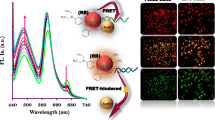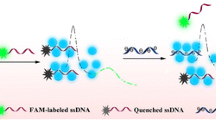Abstract
The dual-emission carbon dots (CDs) are used to fabricate an ultra-sensitive and highly selective fluorescence resonance energy transfer (FRET) aptameric-sensor for the quantitation of Hg(II). The designed strategy worked based on hybridization between T-rich ssDNA(S1) immobilized on CDs and AuNPs modified with complementary aptamer (AuNPs-S2) and Rhodamine B (RB) as an extra internal reference. Under optimized experimental conditions, the intensity ratio of I580/I668 shows a good linear relationship with the Hg(II) concentration in concentration range of 1.0 × 10−18 to 50.0 × 10−5 M with detection limit of 5 × 10−19 M. The proposed FRET aptasensor showed high selectivity for Hg(II) determination even in the presence of other metal ions with higher concentration as high as 1000 times. Furthermore, the RB-CDs probe was demonstrated to be efficient for MDA-MB 231 cell imaging. The bifunctional signaling probe exhibits impressive simplicity, convenience, and low detection time and the proposed sensor can be applied in biomedicine study, food safety, and environmental protection.

Graphical abstract






Similar content being viewed by others
References
Pytharopouloua S, Kournoutoua GG, Leotsinidisb M, Georgiouc CD, Kalpaxis DL (2013) Dysfunctions of the translational machinery in digestive glands of mussels exposed to mercury ions. Aquat Toxicol 134:23–33
Zalups RK (2000) Molecular interactions with mercury in the kidney. Pharmacol Rev 52:113–143
Monikha FA, Karami O, Hosseini M, Karami N, Bastami A, Ghasemi AF (2013) The effect of primary producers of experimental aquatic food chains on mercury and PCB153 biomagnification. Ecotox. Environ. Safe. 94:112–115
Gómez-Ariza JL, Lorenzo F, García-Barrera T (2005) Comparative study of atomic fluorescence spectroscopy and inductively coupled plasma mass spectrometry for mercury and arsenic multispeciation. Anal Bioanal Chem 382:485–492
Fong BMW, Siu TS, Lee JSK, Tam S (2007) Determination of mercury in whole blood and urine by inductively coupled plasma mass spectrometry. J Anal Toxicol 31:281–287
Manna B, Raj CR (2018) Nanostructured sulfur-doped porous reduced graphene oxide for the ultrasensitive electrochemical detection and efficient removal of hg(II). ACS Sustain Chem Eng 6:6175–6182
Amiri S, Navaee A, Salimi A, Ahmadi R (2017) Zeptomolar detection of Hg2+ based on label-free electrochemical aptasensor: one step closer to the dream of single atom detection. Electrochem Commun 78:21–25
Zhou G, Chang J, Pu H, Shi K, Mao S, Sui X, Ren R, Cui S, Chen J (2016) Ultrasensitive mercury ion detection using DNA-functionalized molybdenum disulfide Nanosheet/gold nanoparticle hybrid field-effect transistor device. ACS Sens. 1:295–302
Cui X, Zhu L, Wu J, Hou Y, Wang P, Wang Z, Yang M (2015) A fluorescent biosensor based on carbon dots-labeled Oligodeoxyribonucleotide and graphene oxide for mercury (II) detection. Biosens Bioelectron 63:506–512
Peng D, Zhang L, Liang RP, Qiu JD (2018) Rapid detection of mercury ions based on nitrogen-doped graphene quantum dots accelerating formation of manganese porphyrin. ACS Sens 3:1040–1047
Kong L, Wang J, Zheng G, Liu J (2011) A highly sensitive protocol (FRET/SIMNSEF) for the determination of mercury ions: a unity of fluorescence quenching of graphene and enhancement of nanogold. Chem Commun 47:10389–10391
Amiri S, Ahmadi R, Salimi A, Navee A, Hamd-Qaddare S, Amini MA (2018; Advance Article) Ultrasensetive and highly selective FRET aptasensor for Hg2+ measuring in fish samples using carbon dots/AuNPs as donor/acceptor platform. New J Chem 42:16027–16035
Gu W, Pei X, Cheng Y, Zhang C, Zhang J, Yan Y, Ding C, Xian Y (2017) Black phosphorus quantum dots as the Ratiometric fluorescence probe for trace mercury ion detection based on inner filter effect. ACS Sens. 2:576–582
Tang X, Wang YS, Xue JH, Zhou B, Cao JX, Chen SH, Li MH, Wang XF, Xue F, Zhu YF (2015) Huang Y Q. a novel strategy for dual-channel detection of metallothioneins and mercury based on the conformational switching of functional chimera aptamer. J Pharm Biomed Anal 107:258–264
Chen SH, Wang YS, Chen YS, Tang X, Cao JX, Li MH, Wang XF, Zhu YF, Huang YQ (2015) Dual-channel detection of metallothioneins and mercury based on a mercury-mediated aptamer beacon using thymidine–mercury–thymidine complex as a quencher. Spectrochim Acta A: Mol Spectrosc 151:315–321
Huang YQ, Yin JC, Wang YS, Xiao XL, Zhou B, Xue JH, Tang X, Wang XF, Zhou B, Xue JH, Tang X, Chen SH (2016) Streptavidin and gold nanoparticles-based dual signal amplification for sensitive magnetoelastic sensing of mercury using a specific aptamer probe. Sensors Actuators B Chem 235:507–517
Lu X, Zhang J, Xie YN, Zhang X, Jiang X, Hou X, Wu P (2018) Ratiometric phosphorescent probe for thallium in serum, water, and soil samples based on long-lived, spectrally resolved, Mn-doped ZnSe quantum dots and carbon dots. Anal Chem 90:2939–2945
Ying ZM, Wu Z, Tu B, Tan W, Jiang JH (2017) Genetically encoded fluorescent RNA sensor for Ratiometric imaging of MicroRNA in living tumor cells. JACS. 139:9779–9782
Zhang Y, Li S, Zhao Z (2016) Using Nanoliposomes to construct a FRET-based Ratiometric fluorescent probe for sensing intracellular pH values. Anal Chem 88:12380–12385
Luxami V, Verma M, Rani R, Paula K, Kumar S (2012) FRET-based ratiometric detection of Hg2+ and biothiols using naphthalimide–rhodamine dyads. Org Biomol Chem 10:8076
Song W, Duan W, Liu Y, Ye Z, Chen Y, Chen H, Qi S, Wu J, Liu D, Xiao L, Ren C, Chen X (2017) Ratiometric detection of intracellular lysine and pH with one-pot synthesized dual emissive carbon dots. Anal Chem 89:13626–13633
Wang Y, Shan D, Wu G, Wang H, Ru F, Zhang X, Li L, Qian Y, Lu X (2018) A novel "dual-potential" Ratiometric Electrochemiluminescence DNA sensor based on enhancing and quenching effect by G-quadruplex / hemin and au-Luminol bifunctional nanoparticles. Biosens Bioelectron 106:64–70
Ji R, Liu A, Shen S, Cao X, Li X, Ge Y (2017) An indolizine–rhodamine based FRET fluorescence sensor for highly sensitive and selective detection of Hg2+ in living cells. RSC Adv 7:40829–40833
Teradal NL, Jelinek R (2017) Carbon Nanomaterials in Biological Studies and Biomedicine. Adv Healthc Mater 17:1700574
Yang L, Deng W, Cheng C, Tan Y, Xie Q, Yao S (2018) Fluorescent immunoassay for the detection of pathogenic Bacteria at the single-cell level using carbon dots encapsulated breakable Organosilica Nanocapsule as labels. ACS Appl Mater Interfaces 10:3441–3448
Hamd-Ghadareh S, Salimi A, Parsa S, Fathi F (2018) Simultaneous biosensing of CA125 and CA15-3 tumor markers and imaging of OVCAR-3 andMCF-7 cells lines via bi-color FRET phenomenon using dual blue-green luminescent carbon dots with single excitation wavelength. Int J Biol Macromol 118:617–628
Hamd-Ghadareh S, Salimi A, Fathi F, Bahrami S (2017) An amplified comparative fluorescence resonance energy transfer immunosensing of CA125 tumor marker and ovarian cancer cells using green and economic carbon dots for bio-applications in labeling, imagingand sensing. Biosens Bioelectron 96:308–316
Hamd-Qaddare S, Salimi A (2017) Amplified fluorescent sensing of DNA using luminescent carbon dots and AuNPs/GO as a sensing platform: a novel coupling of FRET and DNA hybridization for homogeneous HIV-1 gene detection at femtomolar level. Biosens Bioelectron 89:773–780
Khramtsov P, Kropaneva M, Kalashnikova T, Bochkova M, Timganova V, Zamorina S, Rayev M (2018) Highly stable conjugates of carbon nanoparticles with DNA aptamers. Langmuir. 34:10321–10332
Gao W, Song H, Wang X, Liu X, Pang X, Zhou Y, Gao B, Peng X (2018) Carbon dots with red emission for sensing of Pt2+, Au3+ and Pd2+ and their bio-applications in vitro and in vivo. ACS Appl Mater Interfaces 10:1147–1154
Wang H, Sun X, Zhang T, Chen X, Zhu J, Xu W, Bai X, Dong B, Cui H, Song H (2018) Photoluminescence enhancement of carbon dots induced by hybrids of photonic crystals and gold–silver alloy nanoparticles. J Mater Chem C 6:147–152
Xiong Y, Schneider J, Reckmeier CJ, Huang HP, Kasákb A, Rogach L (2017) Carbonization conditions influence the emission characteristics and the stability against Photobleaching of nitrogen doped carbon dots. Nanoscale. 9:11730–11738
Hu S, Meng X, Tian F, Yang W, Li N, Xue C, Yang J, Chang Q (2017) Dual photoluminescence centers from inorganic-salt-functionalized carbon dots for ratiometric pH sensing. J Mater Chem C 5:9849–9853
Zhi B, Gallagher MJM, Frank BP, Lyons TY, Qiu TA, Da J, Mensch AC, Hamers RJ, Rosenzweig Z, Fairbrother DH, Haynes CL (2018) Investigation of phosphorous doping effects on polymeric carbon dots: fluorescence, Photostability, and environmental impact. Carbon. 129:438–449
Martindale BC, Hutton GAM, Caputo CA, Prant S, Godin R, Durrant JR, Reisner E (2017) Enhancing light absorption and charge transfer efficiency in carbon dots through graphitization and Core nitrogen doping. Angew Chem 56:6459–6463
Zhou Y, Sharma S, Peng Z, Leblanc R (2017) Polymers in carbon dots: a review. Polymers. 9:67
Chen BB, Liu ML, Zhan L, Li C, Huang MC (2018) Terbium (III) modified fluorescent carbon dots for highly selective and sensitive Ratiometry of stringent. Anal Chem 90:4003–4009
Mohan R, Drbohlavova J, Hubalek J (2018) Dual band emission in carbon dots. Chem Phys Lett 692:196–201
Grabar KC, Freeman RG, Hommer MB, Natan MJ (1995) Preparation and characterization of au colloid monolayers. Anal Chem 67:735–743
Song Y, Jiang T, Nguyen VL, Sparrman T, Björn E, Skyllberg U (2018) Thermodynamics of hg(II) bonding to thiol groups in Suwannee River natural organic matter resolved by competitive ligand exchange, hg LIII-edge EXAFS and 1H NMR spectroscopy. Environ Sci Technol 52:8292–8301
Liu L, Lu Y (2006) Preparation of aptamer-linked gold nanoparticle purple aggregates for colorimetric sensing of analytes. Nat Protoc 1:246–252
Zheng W, Shan N, Yu L, Wang X (2008) UV–visible, fluorescence and EPR properties of porphyrins and metalloporphyrins. Dyes Pigments 77:153–157
Teymourian H, Salimi A, Khezrian S (2017) Development of a new label-free, indicator-free strategy toward ultrasensitive electrochemical DNA biosensing based on Fe3O4 nanoparticles/reduced graphene oxide composite. Electroanalysis 19:409–414
Noorbakhsh A, Salimi A (2011) Development of DNA electrochemical biosensor based on immobilization of ssDNA on the surface of nickel oxide nanoparticles modified glassy carbon Electrode. Biosens Bioelectron 30:188–196
Niu X, Ding Y, Chen C, Zhao H, Lan M (2011) A novel electrochemical biosensor for Hg2+ determination based on Hg2+-induced DNA hybridization. Sensors Actuators B Chem 58:383–387
Orriach-Fernández FJ, Medina-Castillo AL, Díaz-Gómez JE, Muňnoz de la Peňa A, Fernández-Sánchez JF, Fernández-Gutiérrez A (2014) A sensing microfibre mat produced by electrospinning for the turn-on luminescence determination of Hg2+ in water samples. Sensors Actuators B Chem 195:8–14
Zhou Y, Dong H, Li L, Li M, Xiao K, Xu M (2014) Sens. Selective and sensitive colorimetric sensor of mercury (II) based on gold nanoparticles and 4-mercaptophenylboronic acid. Sensors Actuators B Chem 196:106–111
Ren W, Zhang Y, Chen HG, Gao ZF, Li NB, Luo HQ (2016) Ultrasensitive label-free resonance Rayleigh scattering Aptasensor for Hg2+ using Hg2+-triggered exonuclease III-assisted target recycling and growth of G-wires for signal amplification. Anal Chem 88:1385–1390
Li T, Liang G, Li X (2013) Chemiluminescence assay for the sensitive detection of iodide based on extracting Hg2+ from a T–Hg2+–T complex. Analyst 138:1898–1902
Zhuo B, Li Y, Zhang A, Lu F, Chen Y, Gao W (2014) An electrochemiluminescence biosensor for sensitive and selective detection of Hg2+ based on π–π interaction between nucleotides and ferrocene–graphene nanosheets. J Mater Chem B 2:3263–3270
Gao W, Zhang A, Chen Y, Chen Z, Chen Y, Lu F, Chen Z (2013) A novel probe density controllable electrochemiluminescence biosensor for ultra-sensitive detection of Hg2+ based on DNA hybridization optimization with gold nanoparticles array patterned self-assembly platform. Biosens Bioelectron 49:139–145
Babamiri B, Salimi A, Hallaj R (2018) Switchable electrochemiluminescence aptasensor coupled with resonance energy transfer for selective attomolar detection of Hg2+ via CdTe@CdS/dendrimer probe and au nanoparticle quencher. Biosens Bioelectron 102:328–335
Amao Y, Komori T (2004) Bio-photovoltaic conversion device using chlorine-e6 derived from chlorophyll from Spirulina adsorbed on a nanocrystalline TiO2 film electrode. Biosens Bioelectron 19:843–847
Acknowledgments
This work was supported with the Research Office of University of Kurdistan and Iranian Nanotechnology Initiative. We thank Dr. Fardin Fathi and Farzad Soleimani (Kurdistan Medical University for taking cellar fluorescence imaging.
Author information
Authors and Affiliations
Corresponding author
Additional information
Publisher’s note
Springer Nature remains neutral with regard to jurisdictional claims in published maps and institutional affiliations.
Electronic supplementary material
ESM 1
(DOC 490 kb)
Rights and permissions
About this article
Cite this article
Hamd-Ghadareh, S., Salimi, A. DNA-functionalized dye-loaded carbon dots: ultrabright FRET platform for ratiometric detection of Hg(II) in serum samples and cell microenvironment. Ionics 25, 4469–4479 (2019). https://doi.org/10.1007/s11581-019-02999-2
Received:
Revised:
Accepted:
Published:
Issue Date:
DOI: https://doi.org/10.1007/s11581-019-02999-2




